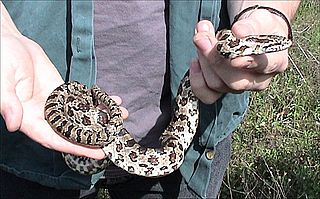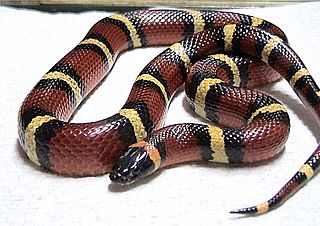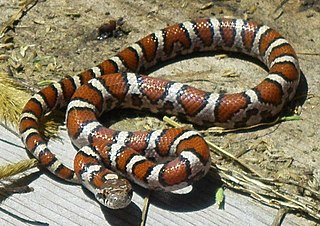
The milk snake or milksnake, is a species of kingsnake; 24 subspecies are currently recognized. Lampropeltis elapsoides, the scarlet kingsnake, was formerly classified as a 25th subspecies, but is now recognized as a distinct species. The subspecies have strikingly different appearances, and many of them have their own common names. Some authorities suggest that this species could be split into several separate species. They are not venomous to humans.

Kingsnakes are colubrid New World members of the genus Lampropeltis, which includes 26 species. Among these, about 45 subspecies are recognized. They are nonvenomous and ophiophagous in diet.

The scarlet kingsnake or scarlet milk snake is a species of kingsnake found in the southeastern and eastern portions of the United States. Like all kingsnakes, they are nonvenomous. They are found in pine flatwoods, hydric hammocks, pine savannas, mesic pine-oak forests, prairies, cultivated fields, and a variety of suburban habitats; not unusually, people find scarlet kingsnakes in their swimming pools, especially during the spring. Until recently, and for much of the 20th century, scarlet kingsnakes were considered a subspecies of the milk snake; however, Pyron and Bubrink demonstrated the phylogenetic distinction of this species and its closer relationship to the mountain kingsnakes of the southwestern United States. These largely fossorial snakes are the smallest of all the species within the genus Lampropeltis, usually ranging from 40 to 50 cm at maturity. The maximum recorded length is in Jonesboro, AR 76.2 cm (30.0 in). Hatchlings range in size from 8 to 18 cm .

The desert kingsnake is a species of kingsnake native to Texas, Arizona, and New Mexico, United States. It is not venomous, colored yellow and black. The desert kingsnake's diet consists of rodents, lizards, and smaller snakes, including rattlesnakes. They normally grow 3–4 ft long, but have been known to grow up to 6.8 ft. They are docile creatures when confronted by humans. If they do not try to escape, often they "play dead" by flipping over onto their backs and lying motionless. Some who domesticate kingsnakes, such as ranchers, do so in the hopes that the kingsnakes will feed on other snakes, which might present more of a threat. It was previously considered a subspecies of the common kingsnake. The desert kingsnake belongs to the Colubridae family, which is the largest family of snakes in the world.

The speckled kingsnake is a nonvenomous species of kingsnake endemic to the United States.

Lampropeltis calligaster is a species of kingsnake known commonly as the prairie kingsnake or yellow-bellied kingsnake.

Lampropeltis annulata, commonly known as the Mexican milk snake, is a non-venomous species of milk snake.
Kenneth Lee Williams was an American herpetologist and author of books on the subject of snake biology and classification. Williams retired from teaching in Northwestern State University's biology department and received emeritus status in 2001. Williams is considered an authority on the milk snake and the herpetology of the Honduran Cloud Forest.

Lampropeltis getula, commonly known as the eastern kingsnake, common kingsnake, or chain kingsnake, is a harmless colubrid species endemic to the United States and Mexico. It has long been a favorite among collectors. Nine subspecies are currently recognized, including the nominate subspecies described here.

Lampropeltis knoblochi, commonly known as the Madrean mountain kingsnake, Knobloch's mountain kingsnake , or the Chihuahuan mountain kingsnake, is a species of colubrid snake residing in western North America.

Lampropeltis triangulum hondurensis, commonly known as the Honduran milk snake, is an egg-laying subspecies of nonvenomous colubrid snake. It is one of the more commonly bred milk snakes in captivity and is one of the larger milk snakes, reaching a length of 5 feet.

Lampropeltis pyromelana, the Arizona mountain kingsnake or Sonoran mountain kingsnake, is a species of snake native to Arizona. It can grow up to 36 inches (910 mm) in length.

Lampropeltis nigra, commonly known as the black kingsnake, is a species of nonvenomous colubrid snake indigenous to the United States. It is a species of kingsnake.

Lampropeltis triangulum triangulum, commonly known as the eastern milk snake or eastern milksnake, is a subspecies of the milk snake. The nonvenomous, colubrid snake is indigenous to eastern and central North America.

Lampropeltis mexicana, the Mexican kingsnake, is a colubrid snake that is endemic to Mexico.
There are several species names which are called "triangulum"; "triangulum" is Latin referring to triangles

Lampropeltis micropholis, commonly known as the Ecuadorian milk snake, is a species of milk snake.

Lampropeltis polyzona, commonly known as the Atlantic Central American milksnake, is a species of nonvenomous snake in the family Colubridae. It is found in Mexico.

















